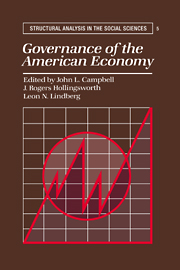Book contents
- Frontmatter
- Contents
- List of figures
- List of tables
- List of contributors
- Preface
- I Conceptual and historical foundations
- 1 Economic governance and the analysis of structural change in the American economy
- 2 The logic of coordinating American manufacturing sectors
- II Empirical studies of governance transformations in the United States
- III Theoretical evaluation of the empirical cases
- References
- Index
2 - The logic of coordinating American manufacturing sectors
Published online by Cambridge University Press: 21 March 2010
- Frontmatter
- Contents
- List of figures
- List of tables
- List of contributors
- Preface
- I Conceptual and historical foundations
- 1 Economic governance and the analysis of structural change in the American economy
- 2 The logic of coordinating American manufacturing sectors
- II Empirical studies of governance transformations in the United States
- III Theoretical evaluation of the empirical cases
- References
- Index
Summary
The previous chapter assumes that in order to comprehend how a particular industrial sector is governed or coordinated at any moment in time, we must first understand the historical process from which the sector evolved. Each governance arrangement is both historically conditioned and contingent. Although this project has as its goal to illuminate variation in the governance of industrial sectors – both across industries and over time within a single industry – we must recognize that there are broad parameters within which this variation takes place in a nation's history. In other words, there are broad styles of governance that are distinct within specific historical epochs in each nation's history. Chapters 3 through 10 focus on transformations of governance structures of particular industries in American history, but this chapter defines the broad parameters within which the governance of various sectors has taken place over time in American society.
Because institutional arrangements emerge over long periods of time, this chapter focuses attention only on the coordination of manufacturing sectors in the American economy during the period since 1870. Due to space limitations, the chapter devotes very little attention to sectors in agriculture, service, or transportation except insofar as they impinge on manufacturing. In many respects, the coordination and governance of American manufacturing during this time frame falls within two distinct periods: 1870 to 1950, and 1950 to the present. Both periods experienced basic transformations in the coordination and governance of the nation's economy.
- Type
- Chapter
- Information
- Governance of the American Economy , pp. 35 - 74Publisher: Cambridge University PressPrint publication year: 1991
- 21
- Cited by



